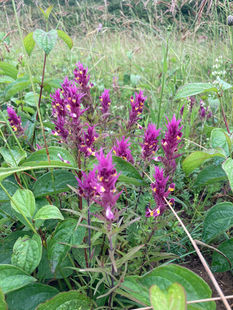Flies
43 species of fly have become extinct in England in the last 200 years, 10 of which are shown below

Species: Belida angelicae
Extinct: 1936

Species: Clitellaria ephippium
Extinct: 1850
© John Reinecke
© Hectonichus


FIELD COW- WHEAT
Melampyrum arvense

A hemi-parasitic member of the Figwort family, occuring in open tussocky grasslands in field boundaries. It used to grow in abundance in crops, and was known as a 'poverty weed' due to its seeds reducing the market value of corn. It has now completely vanished from arable habitats and survives in a handful of sites where open soil conditions are managed for.
-
Rarity: 4 sites, in the south of England.
-
Cause of decline: Agricultural intensification.
Background
Field Cow-wheat was once a relatively common sight in arable fields in the south of England, and on the Isle of Wight was reported as ‘over-running’ fields of wheat and barley. The name of the genus comes from the Greek words melas, meaning black, and pyros meaning wheat.
This is a reference to when seeds were harvested with wheat and after milling turned entire batches of flour a blue-black colour whilst also making it distasteful. In the early 19th century plants used to be pulled by hand and taken off to be burnt.
Ecology and Conservation
Originally believed to be parasitic directly on crops, recent research has suggested that the plants were in fact parasitic on the dicotyledonous plants growing among crops, which partially explains the disappearance of Cow-wheat amongst modern monoculture crops.
Its recent dramatic decline is undoubtedly linked to improvements in seed cleaning technology, which have prevented the seeds contaminating arable crops, coupled with an increased use of pesticides and a move towards spring sown crops.
Nowadays in the UK it tends to fair better on calcareous grassland sites, where it has a wide array of plants to parasitise on, and in theory is less likely to be outcompeted by dense swards of vegetation.
In an amazing bit of evolutionary development the plant produces a seed packed in with an elaiosome - a gland containing oils and sugars which encourages ants to collect the seeds and carry them back to their nests, and we believe this has accounted for the spread of plants at some sites.
Our work
In the 2010s our work focussed on ensuring all the remaining sites in the UK were under suitable longterm management. As the weather has become more severe in recent years we have adapted this management to create a range of microhabitats at key sites, creating a mosaic of shrub and open grassland.
Since 2020 we have worked to expand the overall range of the species, ensuring it does not go extinct in Wiltshire (after the only site changed ownership) and more recently trying to reverse county -level extinctions in Essex and Bedfordshire.






